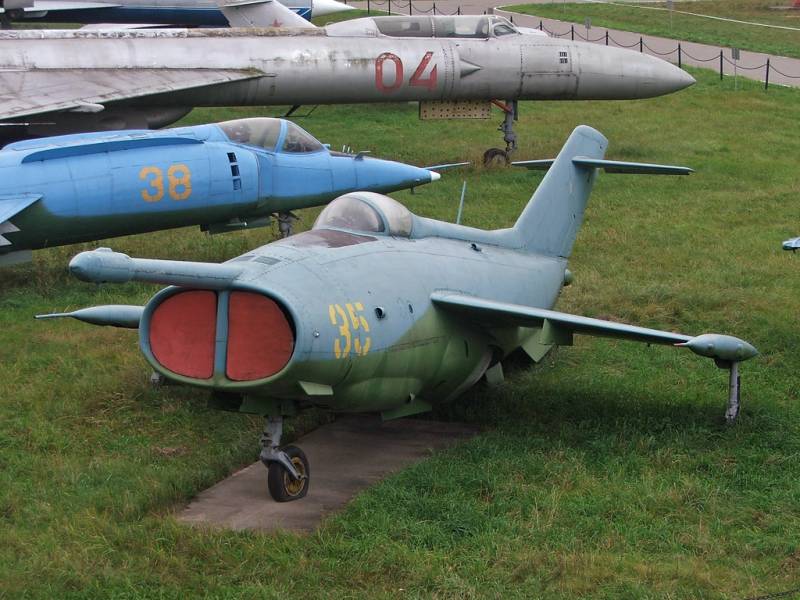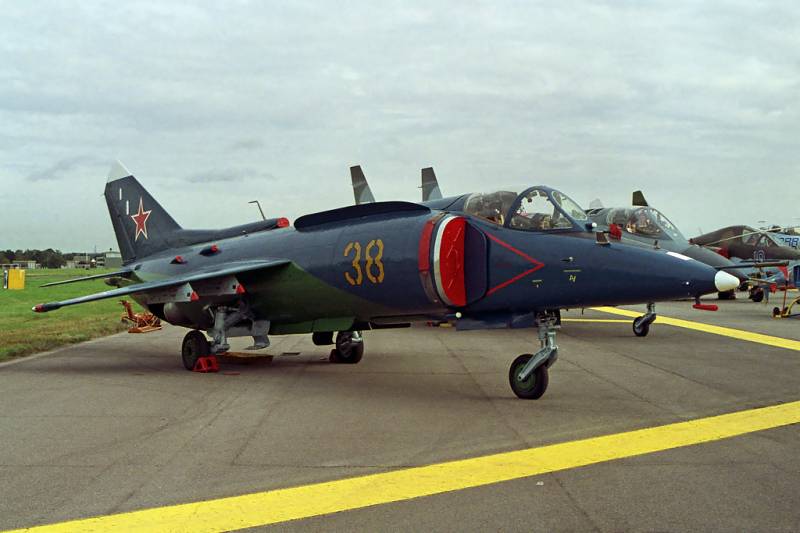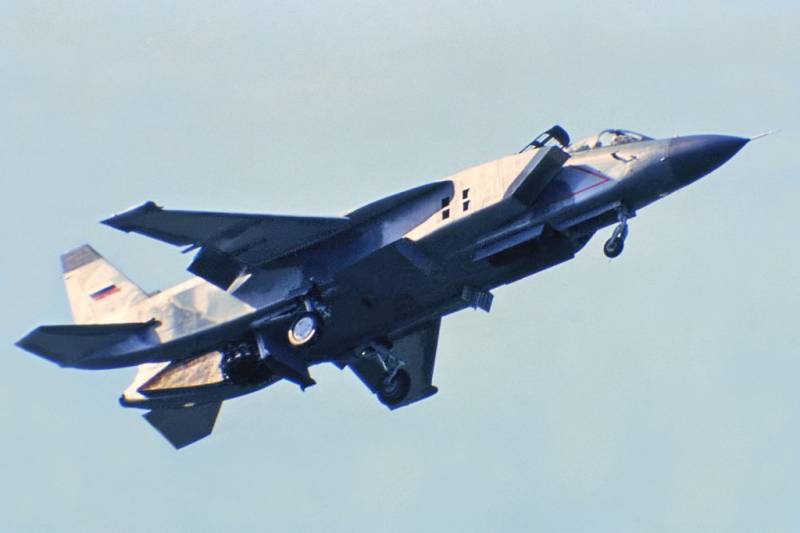Deck plane vertical takeoff. Defense plans and industry experience
In the past, several types of vertical take-off aircraft were developed and mass-produced in our country, but in the early nineties this direction was abandoned. A promising technology has once again begun to appear in the statements of officials only a few months ago. The start of the new discussions was given by the words of the Deputy Minister of Defense Yuri Borisov, voiced at the recent exhibition “Army-2017”.
Plans and statements
Speaking in the framework of the international military-technical forum “Army-2017”, held in August, the Deputy Minister of Defense revealed some plans of the military department in the context of development fleet. According to him, under the new state arms program, it is planned to develop and lay down a new aircraft carrier ship. Construction of a promising aircraft carrier may begin in the middle of the next decade.
In addition, the military are considering the possibility of creating a new aircraft designed for operation on a future aircraft carrier. Y. Borisov noted that such an aircraft may differ by a shortened takeoff or vertical takeoff. However, any details of the new project were not specified. Apparently, at that time, the command had not even formed the desired appearance of the new technology.
In the twenties of November, the Deputy Minister of Defense again raised the topic of building an aircraft carrier, and also touched upon the development of carrier-based aircraft. Y. Borisov recalled the existing Su-33 and MiG-29K aircraft, and also assessed their prospects. According to the deputy minister, such equipment will become obsolete and in ten years will need the creation of a completely new carrier-based aircraft.
Also, the representative of the military department clarified that there are already plans to create a new technology. We are talking about aircraft with a shortened take-off and landing, or about a car with a vertical take-off. The topic of developing new aircraft is being discussed in the context of the future State Armaments Program, which will operate until the middle of the next decade.
Just a few days ago, the aviation industry announced its view of the plans of the Ministry of Defense. The new information was announced by the Vice-President of the United Aircraft Corporation Sergey Korotkov and published by the Interfax news agency. The vice-president for innovation said that the KLA has the necessary scientific and technological reserve with which it will be possible to create promising vertical take-off aircraft for the new aircraft carrier.
S. Korotkov confirmed that the talk about the creation of vertical take-off aircraft is indeed conducted in the relevant circles. In addition, he recalled that even in the times of the Soviet Union a serious groundwork had been created in this area. The development bureau of A.S. Yakovlev. S. Korotkov believes that the achievements of this organization even now can be considered modern. With the appearance of the relevant order of the Ministry of Defense, the aviation industry can return to long-forgotten ideas.
In the past, even before the collapse of the USSR, several projects of vertical take-off aircraft were created by the designers of the Yakovlev company. Prototypes were built and tested. Also mass production was established. In the early nineties, work in this direction was suspended. Nevertheless, the technologies used in these projects, according to S. Korotkov, are still of interest.
The vice-president of the UAC believes that new ideas require new approaches: the development of promising aircraft should be carried out taking into account modern realities. Things done in the past lose their potential over time, first becoming mediocre and then completely losing relevance.
As follows from the words of S. Korotkov, the United Aircraft Corporation is not going to develop promising vertical or short take-off aircraft. Everything will depend on the wishes and decisions of the Ministry of Defense. If the command decides to order such equipment, the task will be set, and the industry will solve it.
History issue
Soviet aircraft designers took up the subject of vertical or short take-off aircraft in the late fifties. All the major design bureaus that specialized in fighter aircraft offered their versions of prototypes with various capabilities. The bureau of A.S. Yakovlev. It is this organization from the beginning of the sixties led the development of new aircraft, some of which even reached mass production and operation in naval aviation.
The first domestic aircraft of vertical take-off and landing remained in history under the name Yak-36. It was a traditional aerodynamic machine with two turbojet engines of sufficient power, equipped with rotating nozzles. For control on the modes of vertical take-off and hovering, gas rudders were used that were carried out on a special nose rod. It was built four prototypes of this type, which had certain differences. Despite the experimental nature of the project, the aircraft could carry up to 2 and missile and bomb weapons. Tests of four Yak-36 allowed to collect the necessary data and begin to develop a new machine that can fully solve combat missions.
A further development of the Yak-36 aircraft was the Yak-36М / Yak-38 project, within which the design of a deck attack aircraft for vertical take-off was proposed. This machine complied with the requirements of the Navy, which led to corresponding positive consequences. Yak-38 became the first Soviet car of its class, adopted for service and put in the series.
Yak-38 was equipped with two main-lift engines and one used only for vertical take-off and landing. The machine was completed with both aerodynamic and gas rudders. For greater safety of the pilot, the existing ejection seat was supplemented with an automatic control system. In the event of entering into unacceptable modes during vertical flight or hovering, the automatics had to save the pilot on their own. Aircraft Yak-36М / Yak-38 could carry a container with an automatic cannon, missiles and bombs of different types. The vertical take-off combat load was limited to 1000 kg. In the usual run-up, the plane could take up to 1,5 t weapons.
In the mid-seventies, mass production of new aircraft was launched in the interests of the navy. The Yak-38 could be used both on coastal airfields and on the aircraft-carrying cruisers of the 1143 “Krechet” project. Due to the limited size of the flight deck of such ships, the Yak-38 attack aircraft were used as vertical take-off aircraft.
In the mid-eighties, an improved version of the existing machine called the Yak-38M was created. Due to a certain processing of the structure and the use of new units, it was possible to obtain an increase in some characteristics. Overall capabilities, however, in general, remained at the same level.
A total of about 230 Yak-38 and Yak-38М were built. This technique was actively used by naval aviation, but the reviews about it were very restrained. The aircraft were not equipped with airborne radar, which reduced their combat potential. High fuel consumption of the three engines also adversely affected flight performance. Stormtroopers, flying up vertically, could carry only 1 t payload, consisting mainly of uncontrolled weapons. In addition, the vertical take-off and landing reduced the combat radius: this parameter did not exceed 200 km. Navy wits could not get past this feature of the aircraft, and came up with the insulting nicknames of the “mast defense plane”, “the deterrent weapon (it took off, scared, sat down)”, etc.
From the mid-seventies, the Yakovlev Design Bureau developed the Yak-41 vertical take-off aircraft, which was later renamed the Yak-141. During its creation it was planned to take into account the experience of testing and operating the existing Yak-38, as well as to eliminate the identified problems. By the mid-eighties, the project reached the stage of building prototypes. Ground checks continued until the 1987 year, when permission was received for the first flight.
The main feature of the project Yak-41 / 141 was the use of lift-main engine with a rotary nozzle, which provided horizontal and vertical take-off. During the vertical take-off, two additional lifting engines were also to be used. Aerodynamic control surfaces were complemented by a gas-jet system. To obtain the desired characteristics in vertical flight modes, we had to use an unusual airframe design. The main engine was moved to the center of the machine, and on its sides were placed two beams with tail assembly nodes.
Yak-141 had to reach speeds up to 1800 km / h and rise to heights up to 15 km. With a vertical take-off, he could lift the 1 t mass load, with an abrupt takeoff run, the 2,6 t. The aircraft had its own 30-mm automatic gun, and could also carry missiles and bombs, both free-falling and controlled. The presence of airborne radar significantly increased the combat potential of the aircraft in comparison with its predecessors.
Two aircrafts Yak-41 / 141 for several years performed more than 250 test flights in all modes. In 1991, the first landing on the deck of an aircraft carrier was made. In the foreseeable future, new-type production aircraft would have been incorporated into the deck aviation group of new aircraft carriers. However, this did not happen. An accident occurred in 1991, which resulted in one of the prototypes exiting the test program. In addition, the financing of the project was sharply reduced. Subsequent events led to a halt in work. Two prototypes used in flight tests, later became museum exhibits.
In the future, domestic aircraft manufacturers were working on certain variants of vertical or short take-off aircraft, but none of these projects even reached the construction of experimental equipment.
Future
According to several recent statements, the Russian military has again begun to show interest in vertical take-off aircraft. Moreover, the creation of a new machine of this class can be envisaged in the new state armament program. As indicated, such an aircraft should be developed in order to equip a promising aircraft carrier, whose construction starts in the distant future. Naturally, the development will start only if the military department decides to re-equip the carrier-based aircraft and reduce the share of "traditional" aircraft.
At the moment, apparently, the military is only considering the very possibility of equipping aircraft carriers with vertical take-off aircraft. As a result, any opinions on the appearance of the latter, if they exist, have not yet been turned into a full-fledged technical task. However, this may happen in the foreseeable future, and the industry will receive a list of requirements for a new aircraft.
How exactly the new domestic deck-based aircraft will look like - it's too early to say. At the same time, you can try to analyze the available information and make some predictions. So, evaluating the approximate characteristics of the future car, you should take into account foreign experience. To date, the United States has established a serial production of F-35B Lightning II airplanes, capable of taking off with a short run and land vertically. Obviously, such machines will never enter into service with the Russian Navy, but in this case, they clearly show what equipment can be created with the current level of technology.
The F-35B fighter-bomber shows that a modern machine of this class, without losing its flight characteristics, is capable of carrying weapons of several tons, developing supersonic speeds and solving combat missions at distances of hundreds of kilometers from the base. At the same time, however, obtaining such technical characteristics and combat capabilities was directly related to the solution of a number of complex tasks. Moreover, not all of them have been resolved by now.
It can be assumed that when creating a technical assignment for a new carrier-based aircraft, the Russian military department will take into account foreign experience. In addition, it is possible to form requirements with a direct eye on the American project. However, we cannot exclude another scenario, in which the groundwork for domestic enterprises will form the basis of the assignment.
It should be noted that the construction of a new aircraft carrier belongs to the mid-twenties. In the same period, the project of a prospective carrier-based aircraft will have to appear. Thus, work in the field of carrier-based aviation should begin in the foreseeable future, no later than in the next few years.
News about the start of work may appear at any time. At the same time, this or that information of a technical nature will be available to open access However, the Ministry of Defense and the aviation industry are unlikely to immediately publish all the interesting data. However, for obvious reasons, in the near future the situation is unlikely to move beyond preliminary discussions, which is why the public will have to wait for news on the progress of the project.
On the materials of the sites:
http://ria.ru/
http://interfax.ru/
http://tass.ru/
https://tvzvezda.ru/
https://aex.ru/
http://airwar.ru/




Information